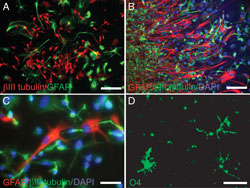Developing an Atlas of Gene Expression by Human Neural Stem and Progenitor Cells

(A) E/sox2:EGFP+ cells were differentiated in DMEM/F12/1% FBS at passage 1. The resultant progeny included both neurons (βIII-tubulin, red) and astrocytes (GFAP, green). At passage 3, E/sox2:EGFP+ cells still readily differentiated into neurons and astrocytes (B–C), as well as O4-defined oligodendrocytes (D).
The biology of human brain cells differs substantially from that of laboratory animals. As a result, while the molecular data obtained from rodent models has been extraordinarily valuable in understanding basic cell and molecular biology of development, it has fallen short in identifying appropriate targets for therapeutic intervention; the predictive value of these models in modulating human brain function has proven marginal. To provide a stronger basis for the lab’s translationally-oriented studies, we have thus established a molecular atlas of differential gene expression by human neural stem and progenitor cells of both the adult and fetal human brain. The generation of this atlas required the invention of several new techniques for phenotype-specific cell identification, FACS isolation and profiling, which comprise a coherent body of patents and papers spanning the past 15 years. Our resultant genomic encyclopedia provides us a unique molecular database upon which to identify those transcriptional changes involved in both tumorigenesis and cell fate decisions. Going forward, we anticipate this database to be crucial over the next decade in essentially all of our major efforts: to induce neurogenesis and gliogenesis from endogenous progenitors; to abrogate tumorigenesis from endogenous progenitor cells; and to instruct differentiated cell fates from pluripotential stem cells.







